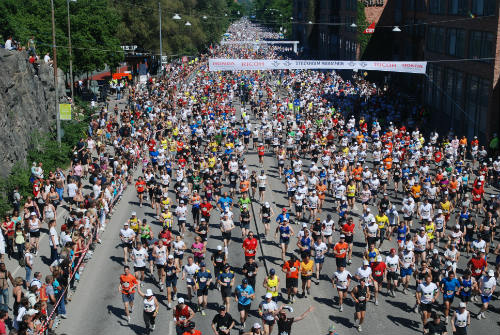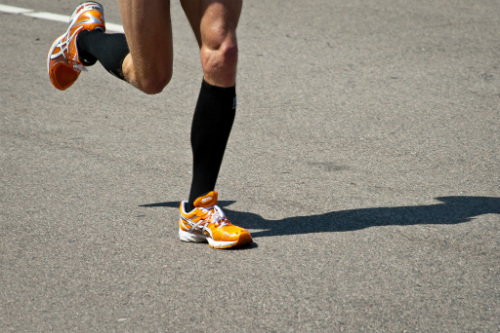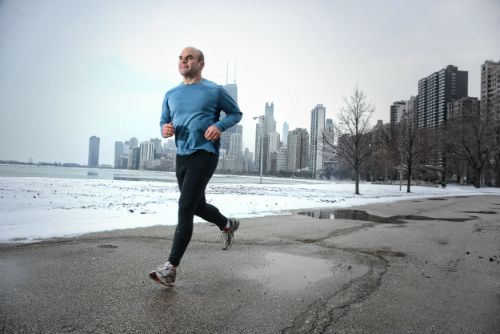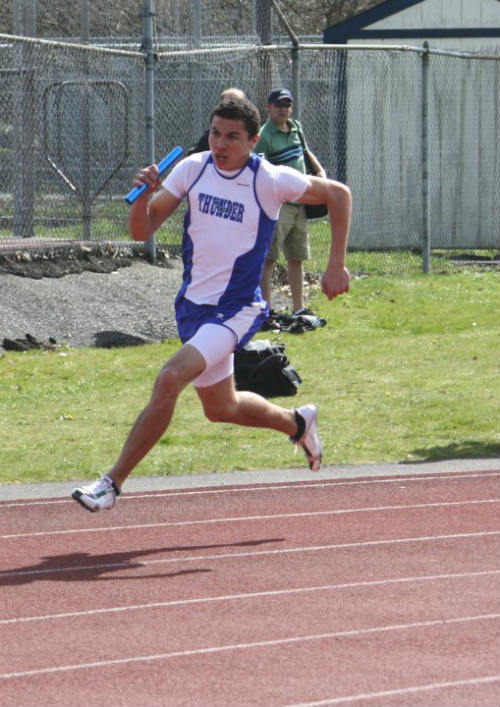- Runners who strike with greater force, increased vertical impact peaks, and increased vertical load rates have a higher risk for injuries requiring medical attention.
- Higher impact forces at landing increased the risk of bony and soft tissue injuries.
- Runners who have never been injured had the lowest impact loading of all studied groups.
- Vertical average loading rate was the strongest predictor of injury risk.
Running season is picking up again with spring around the corner. Many runners either start up where they left off last fall or move from treadmill training to road running. Many of your patients will be training for spring marathons (Figure 1), meaning that they will soon begin to run more miles at faster paces. And, many will suffer running-related injuries.

As many as 90% of them will report running-related injuries.
Many of your patients will run for exercise, competition, stress reduction, and for fun. However, as many as 90% of runners will suffer a running-related injury at some point in their lives, according to an article published recently in The New York Times. These runners miss training time every year due to injury and they incur personal and healthcare-related costs.
Of course, endurance running is not a new thing for humans. “Endurance running is an important activity as it has been suggested to be critical to our evolutionary survival,” according to a report published in Nature in 2004.
New data from a study published in a recent issue of the British Journal of Sports Medicine (BJSM) suggest that being light on one’s feet is the secret to maintaining health during training.
Data from the British Journal of Sports Medicine
The results of the BJSM study offer insight into which runners are at highest risk of injury and suggest techniques for preventing those injuries. (Figure 2.)

According to this study, the key factor associated with injury rates in runners is a simple one: It is the impact force with which the runner’s foot strikes the surface on which she is running. Runners who strike with higher force are injured significantly more frequently than runners who strike softly.
Pounding—high-force foot striking—is inevitable during a run. But runners with similar body types and running styles strike with highly variable force and amounts of impact loading.

and an increased number of running-related injuries.
The Analysis
Running has been critical to human survival, according to the BJSM study. “Therefore, the high rate of injuries experienced by modern day runners is puzzling. Landing on the heel, as most modern day shod runners do, results in a distinct vertical impact force that has been shown to be associated with running-related injuries. However, these injury studies were retrospective in nature and do not establish cause and effect,” the researchers explained.
The BJMS researchers endeavored to determine whether runners who strike the running surface with a high-force impact are at greater risk for developing injuries that require medical intervention.
The researchers recruited 249 experienced female recreational runners who underwent a gait analysis to measure vertical instantaneous loading rate, vertical average loading rate (VALR), vertical impact peak (VIP) and peak vertical force. The participants then recorded their mileage and any running-related injuries monthly in a web-based, database program. The runners were tracked for 2 years.
During that time, more than 100 of the runners reported sustaining an injury that was serious enough to require medical attention. Approximately 40 of the runners reported minor injuries. The remainder suffered no significant injuries.
Results
The observed variables were first compared between the entire injured (INJ; n=144) and uninjured (n=105) groups. However, the focus of this study was on those injured runners seeking medical attention (n=103) and those who had never suffered injury (n=21).
There were no differences among members of injured and uninjured groups. “However, all impact-related variables were higher in those with medically diagnosed injuries compared with those who had never been injured,” the researchers note. The effect size (ES) ranged from 0.4 to 0.59). When VALR was >66.0 body weight (BW)/s, the odds of being diagnosed with an injury were 2.72 (95% CI 1.0 to 7.4). Impact loading was associated with both bony and soft-tissue injuries.
Conclusions
According to the BJSM study, the vertical average loading rate was lower in female runners who had never suffered a running-related injury compared with those who had suffered an injury and sought medical attention for that injury.
Of the studied runners, 21 not only did not become injured during the 2-year study but also had never suffered a running-related injury. The researchers decided to compare impact loading among runners in the never-injured group with force loading exerted by the seriously injured runners.
The data revealed that the force with which the foot strikes the running surface correlated strongly with the rate of injuries among these runners. “The never-injured runners, as a group, landed far more lightly than those who had been seriously hurt, the scientists found, even when the researchers controlled for running mileage, body weight and other variables,” the New York Times reported. “That finding refutes the widely held belief that a runner cannot land lightly on her heels.”.
“One of the runners we studied, a woman who has run multiple marathons and never been hurt, had some of the lowest rates of loading that we’ve ever seen,” lead researcher Irene Davis, PhD, told the New York Times. Dr. Davis is Director of Spaulding National Running Center in the Department of Physical Medicine and Rehabilitation at Harvard Medical School, in Cambridge, Mass.
Midfoot Striking
The data also contain a more general message for runners: It may be beneficial to consciously think about a soft landing, Dr. Davis said. This can take some time for experienced runners to accomplish, but switching from heel striking to midfoot striking (Figure 2)—especially for runners with a long history of injuries—might result in fewer injuries versus heel striking (Figure 3). Another injury prevention strategy to consider is to increase one’s cadence. By increasing the number of steps taken per minute, the force of each foot strike can be reduced. Two other factors correlated with high-impact foot striking were running speed (Figure 4) and running downhill. Running up hill has been correlated with decreased foot striking forces.

and increased rates of running-related injuries.
Conclusions
Runners who strike the running surface with higher forces, with increased, vertical impact peaks, and vertical load rates, have an increased risk for injuries requiring medical attention. These injuries include both bony and soft tissue injuries. Vertical average loading rate was the strongest predictor of injury risk. According to the BJSM study, runners who had never been injured had the lowest impact loading of all studied groups.
These data suggest that runners who strike with high degrees of force are at increased risk for running-related injuries. Strategies to reduce vertical impact loading in these runners may result in a reduction of running-related injuries. “Gait retraining interventions, such as focusing on transitioning to a forefoot strike pattern, has been previously shown to reduce injuries in runners and should be considered as a treatment for impact-related running injuries,” wrote the authors of the BJSM study.
